The Duck Decoy is a less common antique object with a broad and exciting history. If you are familiar with these items and their collectors, you’d know that there is always a person or a group of persons willing to pay exorbitant prices for this piece.
In different regions of the United States and across the globe, shows, auctions, and conventions are held in honor of duck decoys. Any vintage duck decoy, regardless of its availability, details, manufacturers (carvers), or age, can be worth lots of dollars.
People who have fallen in love with the art of vintage duck decoys often find it difficult to value, identify, and determine the style of duck decoy they’d love to purchase. This in itself is a tricky task. Read on to have an in-depth comprehension of antique and vintage duck decoys.
Table of Contents
The History Of Antique Duck Decoys
The exact date the first duck decoy was produced is not recorded; however, I can categorically state that this art has existed for at least a thousand years.
When the first colonists settled in North America, they observed that the natives of the land used bulrushes, fowl carcasses, and mud to create duck and fowl-like figures. They reported that these imitations served as prey to other live birds. The hunters who lie in wait would then capture the live birds that approach the dummy. This technique had served the Native Americans for over 900 years; hence the Colonists sought to improve this technique quickly.
Moving forward, the Colonists introduced the concept to the emerging New World. At this point, hunting was growing to be a pastime for privileged individuals in England. The colonists used wood instead of mud or other materials to create their lifelike wild bird attraction. The word “decoy” is a dutch word that refers to the cages used by hunters in the Old World to tame wild animals, especially birds.
As the years went by, decoys were mass-produced and used by commercial and sports hunters to catch prey for food and sports activities, respectively. By the mid-19th century, the style and construction of decoys began to vary based on the region and the carver. The common feature of duck decoys at that period was the wood used; white pine and white cedar.
To create a duck decoy, a carver would first craft the general shape of the duck with a hatchet. The smoothing and fine-tuning aspect would be completed with a drawknife. To create the head, the carver uses an ax to cut off a small woodblock. Next, they begin to carve the head with a jackknife till they get their desired shape. Nails or long spikes are used to join the head and the decoy’s body.
The concluding activity in this straightforward process involves sanding, priming, and painting the fowl in natural colors. Often, the color used depends on the variety of ducks and fowls found within that region. The texture also differed based on region. In Maine, the carvers made the decoys have tougher features to withstand the waters.
This technique helped families during the civil war to catch prey for feeding. During this period, it was more or less an art form practiced by adults and children alike—some carved duck decoys for commercial purposes. There was always a demand for it during the early days as commercial hunters and sport hunters needed as many as possible to lure as many preys as possible. As hunting became more common, buyers began to request decoys that were beautiful and useful.
In regions where hunting wasn’t as expected, duck decoys were used as decorative pieces until the next hunting season. At the time, not all duck decoys had the same value. Carvers were making a few decoys of better quality with improved materials and more intricate designs for the wealthy.
Vintage and antique duck decoys have different designs, depending on their intended purpose. Some are built to float; these were used to attract large fowls like ducks and geeks who often frequent water areas. A few of these floating decoys appear buoyant because they were hollowed out, while the rest maintained their solid features. Carvers also designed a group of decoys that appear to have legs. Stick Ups were used to lift the body off the ground. However, the majority had two-dimensional profiles.
Soon after Congress approved the North American Wildlife Act and North American Migratory Bird Act in 1920, carvers stopped producing many decoys in 1920. The measure immediately put a stop to commercial and sport hunting. In turn, the demand for decoys grind to a halt. In the mid-1900s, duck decoys were as scarce as ever and were regarded as collectible items of folk art.
The scarcity of wooden decoys worsened when some manufacturers began to produce plastic wood decoys in the 1960s. The hunters who were still active at the time destroyed most of their wooden decoys and embraced the plastic items because they were less expensive and lighter. It wasn’t until the late 1900s that many of the vintage lures we have now emerged as collector’s items.
Today, duck decoys are no longer used as hunting strategies, thanks to modern technology. Hence, these items are regarded as antique and vintage. Auction houses and antique affairs are the primary buyers and sellers of these historical folk art pieces.
How To Identify Antique Duck Decoys
Professional and expert collectors find it easy to identify markings and details on duck decoys because they’ve had years to study these vintage items. Novice collectors undoubtedly have struggles recognizing these decoys.
Most vintage duck decoys do not have identifiable markings. One must instead learn to differentiate an actual bait from a modern decoy. You must carefully inspect the duck item. Vintage and antique duck decoys look and feel old. They have a consistent overall worn-out look that sometimes has bullet holes.
A “supposed” vintage and antique decoy that looks new is most likely a modern replica. It would be best if you also inspected the eyes of the decoy. Antique duck or fowl decoys have glass eyes.
You should also check the markings on the decoy. In the early days, most carvers engraved their initials and date on the bottom of the decoy. While a few make the markings on the wing side. Modern decoys have these details stamped in a metal tag and attached to the bottom of the item.
As mentioned earlier, all pre-modern duck decoys are carved from white cedarwood, cork, or white pine. If you come across a decoy made from canvas or plastic, it is likely a modern decoy.
Learning to identify vintage and antique duck decoys is an art lesson. There are other videos, articles, and books you can consult on this subject to learn to recognize these antique items. Stephen O’Brien of Copley Fine Art Auctions, Boston, said studying Adele Earnest’s The Art of the Decoy would go a long way in familiarizing oneself with the fine details of duck decoys. Other books recommended by folk art experts include American Bird Decoys by William J. Mackey Jr. and Wild Fowl Decoys by Joel Barber.
For practice, you can attend decoy auctions, and hunting shows to get on-hand experience. In these events, you’ll be opportune to inspect subtle features put in by antique carvers.
Better still, here’s a YouTube video.
Factors That Affect Antique Duck Decoy Values
Duck decoys vary in value. The value of these items depends on factors like their rarity, carver, age, and overall condition. Sometimes, it could depend on the pose of the decoy; some duck decoys are carved in feeding, swimming, and even sleeping positions. Although, these were mainly used for decorative purposes in the homes of the wealthy during the early years.
Duck decoys do not and cannot have a fixed price. The market is continually evolving, so today’s price may not be tomorrow’s.
Here are the factors that determine the final price of an antique duck decoy:
1.Size
The size of duck decoys differs depending on the breed the carver is trying to imitate. Bigger duck decoys are likely to cost more.
2.Reputation of the Carver
Some makers are more renowned and talented than others. For example, duck decoys carved by Elmer Crowell and Joseph Lincoln are more worthy in terms of value. Both carvers are renowned for their excellent accomplishments in the carving industry.
3.Condition
The current condition of an antique duck decoy plays a significant role in determining its value. Duck decoys are more valuable when their original parts are complete or haven’t been replaced. Antiques that have been altered, repaired, or have missing parts often cost less than the original piece.
Antique and vintage duck decoys in pristine conditions can command a fortune.
4.Strength of maker attribution
Some manufacturers inscribe particular one-of-a-kind features to their duck decoys. If you have one of these, you may be in possession of a treasured antique piece.
5.Region
Some regions like New Jersey, North Carolina, New England, and Long Island are home to duck decoys bearing key features and markings. Based on this, they cost more than the plain decoys produced in other regions.
6.Rarity
As with all antique items, the rare models of duck decoys which are often hard to locate, tend to cost a whole lot more than others. For instance, the Mason Factory Wood Duck is one of the rarest unique models of wood decoy. At the last listing, it cost up to $650,000.
Assessing Antique Duck Decoy Value
Antique and vintage Duck decoys, especially those for commercial and sport hunting hundreds of years ago, are not expected to be found in tiptop condition. Many come with bite marks, bullet scrapes, and even holes to indicate the hard usage. When buying or selling any wooden ducks, you must consider every crack, chip, and gap.
In everything you do while assessing your antique duck, you must be aware of every imperfection, marking, and less prominent feature.
An antique duck decoy with some imperfections.
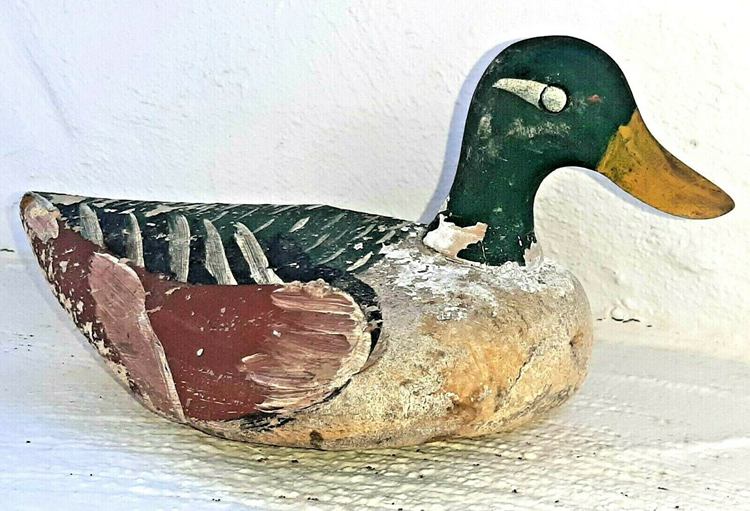
Source: eBay
Price: $80
Things to consider when determining the value range of vintage duck decoys include:
Vintage Duck Decoy Makers
One of the most popular and highly sought-after antique duck decoy brands is the Mason Decoy company.
Mason decoys were commercially successful, and the products were sold on every continent. The mason decoys were carved from white cedar, lathe patterned, and took pleasing shapes. Some of the lures in this range were handpainted in eye-catching natural shades, which were easy to spot.
Vintage mason decoys are relatively more valuable than other commercially produced duck decoys. Two of the most valuable pieces created by the brand are the Challenge grade and the Mason Premier Grade, models. Both decoys have detailed paint designs, solid bodies, flat bottoms, and hollow centers.
The company also manufactured models which were much more affordable for the middle and lower classes.
Vintage Duck Decoy Types
When accessing your vintage duck decoys, research their purpose. Some duck decoys were carved for hunting, some for decoration, while a few served both purposes. Whenever you attend an antique event or visit an antique store, you may also find very tiny decoys and larger ones.
Vintage Duck Decoy Condition
The form and condition of the vintage item is another vital feature to assess. The primary reason why some duck decoys are highly-priced is not that they’re rare or produced by the best carvers; instead, it is because they are still in good condition. Guyette of Guyette and Deeter auctions once explained that about 90% of the available antique duck decoys had been repainted or renailed. Hence the reason why most of them are sold for $100 or less.
An original Elmer Crowell black duck in the best condition can be sold for $2,000 or more in an auction. The rarest species of Mason Factory Wood Duck decoys in the best forms can cost up to $600,000. Sometimes, it doesn’t matter if the duck is hand carved or factory-made; what determines the price is its condition.
Valuable Antique Duck Decoys
There are hundreds of valuable duck decoys worldwide. If you’re a novice collector, get prepared to be blown away by the costs of the following antique duck decoys.
The details of these ridiculously expensive vintage items are captivating. Their makers are top carvers who practiced for years to attain their renowned reputation. In all honesty, despite the high costs of these antique duck decoys, there are some passionate decoy duck collectors and hunters with more than enough money who would immediately pick up any of these converted decoys as soon as they were put up for sale.
1.The Crowell Bundle
This is the most expensive decoy bundle ever sold to date. It comprises two duck decoys, and both are worth $1,130,000. The Crowell two duck decoys were carved by Massachusetts native Elmer Crowell.
Crowell began his carving career in the early 1900s and continued carving excessively till he kicked the bucket in 1952. Even while dead, Crowell is still taking in tons of money. He was renowned for his artistic vintage decoys that featured multiple intricate details. Some decades ago, the Fine Arts of Boston picked up a few of his works and saved them in their museum.
Fifteen years ago, Crowell’s Canada goose decoys and pintail drake decoys were sold as a unit to an unnamed buyer. Both pieces were created between 1915 and 1917. Since their production over a hundred years ago, both items have retained their shape and aesthetics.
The Crowell Bundle extensively includes 31 decoys, all of which were valued at $7.5 million. Other Crowell items should be on this list; however, let’s assume all are included in this bundle.
Stephen B. O’Brien Jr with the record breaking pair of Duck Decoy by Elmer Crowell
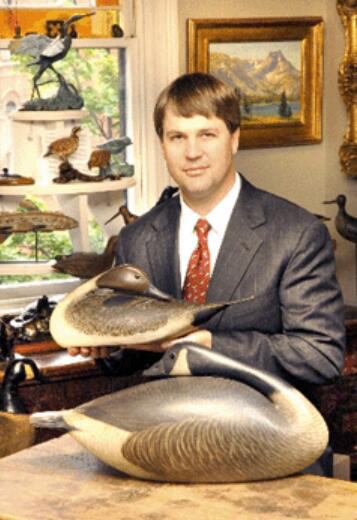
2.The Eider Drake Decoy
This piece is shrouded in a tone of mystery. The original carver of the work is unknown, and all indications point out that no one will ever find out.
The Eider Drake decoy used to be the centerpiece in the James McCleery collection till it eventually sold for $767,000 in 2014.
Early 1900s Duck Decoys
Price: $1,650
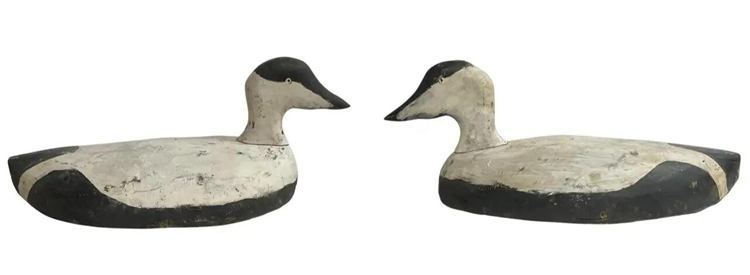
3.The Merganser Hen Carving
The legendary Lothrop Holmes carved this piece. Although it wasn’t as expensive as the paired Crowell Bundle, this single pair sold for a whopping $856,000. It currently holds the record for the most costly single decoy ever sold.
Lothrop Holmes is also a Massachusetts native-like Crowell. However, Lothrop started as a Ship Carpenter and carved only as a hobby. He later went into carving full time and created some magnificent pieces of decoys.
Lothrop also has another notable duck decoy called the Ruddy Turnstone. This pulled in almost $500,000 in 2000. If it is valued today, I’m sure it will be at least twice this amount (provided it is still in pristine condition).
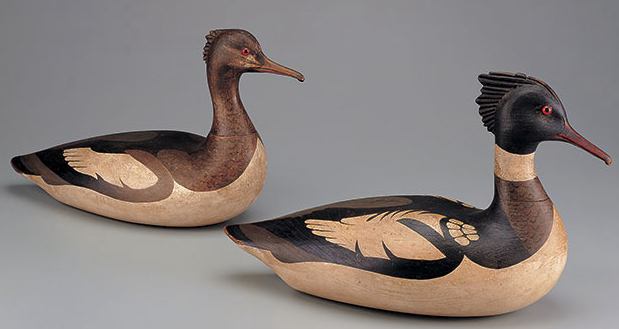
4.The Wilson Drake Duck Decoy
Created by Gus Wilson, this antique item broke one of the antique duck decoy sales record recently. Unlike many other vintage duck decoys curated here that were sold at least ten years ago, the Wilson Drake was sold in 2017.
Gus Wilson wasn’t the best decoy carver, yet this item still generated over $300,000 at the point of sales. Gus did not make hundreds of decoys like his counterparts, and the majority of the ones he carved did not possess the best beaks.
Many of Gus’ pieces have had their beaks repaired or replaced. This antique drake decoy cost this much because it still possessed its original beak.
Price: $335,000
5.Cobb Brant Mallard Duck Decoys
Cobb Brant is one of the earliest duck carvers. He was born in 1825, and he began carving at a young age. There is limited information on Brant. But, an individual duck decoy carved by him pulled in $168,000.
6.The Blaird Mallard decoy
Carved by John Blair, this simple antique piece fetched about $214,000.
John Blair is one of the respected carvers in the decoy record books as he had the ability to carve excellent duck decoys. Not all of Blair’s pieces are worth this much. Some of his pieces have been sold for less than $20,000. Yet, this particular antique keeps getting traded at higher resale values
7.Graves Mallard Decoys
The Graves decoys cannot be compared to world-famous antique items. This piece pulled in enormous amounts of money at the 2006 G&S auction. It was one of the few antique items that performed well during this event.
The Graves antiques are more recent than the Holmes or Crowell pieces. The latest one was made less than a year ago, in 1956.
A pair of Graves Mallard Duck Decoys
Price: $8,100
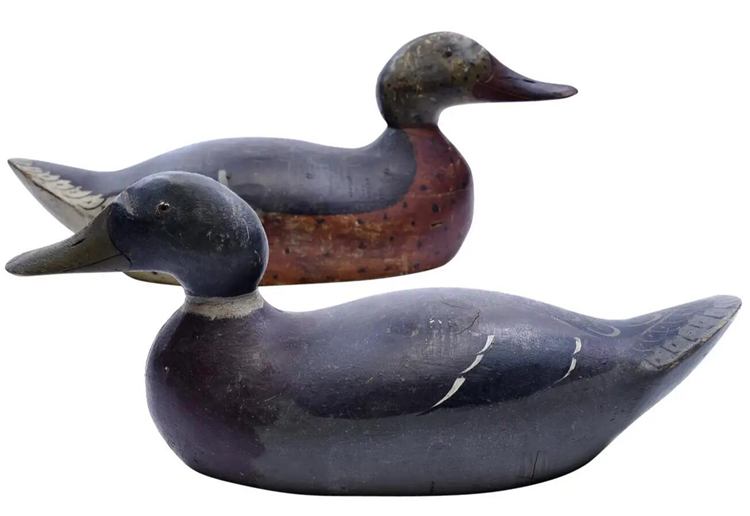
8.Simple Wood Duck by Thomas Chambers
This wood duck was sold for $187,000 in 2004. Unlike other carvers on this list, Chambers was born in Ontario, Canada.
Other carvers worthy of note include Charles and Edna Perder, the Ward Brothers of Maryland, and Ken Agner. Some factories also produced some notable vintage duck decoys in the 1900s. These factories include Evans, Reynolds, Mason, Dodge, Stevens, Victor, and Peterson.
Final Note
Antique Duck decoys are as valuable as many other vintage and antique items. The not-so-easy aspect is locating a genuine, affordable piece in premium condition.
With the above information, you would be able to successfully delve into the vintage duck decoy ecosystem without any hindrance.
So now, head on to eBay, Etsy, 1stDibs, Amazon, or any antique store close to you to buy or list your original vintage duck decoys.
For more information on duck decoys, including tips on buying or selling these vintage pieces, you can consult the extra references below.
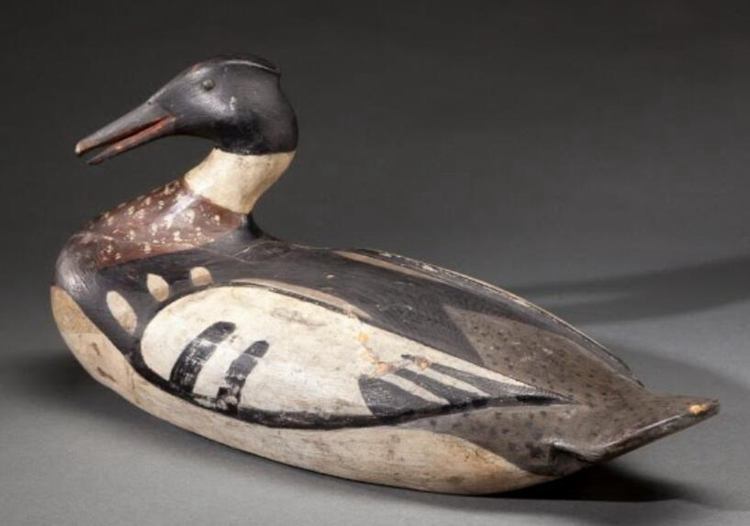






![Vintage Schwinn Bikes: [Types, Identification, and Values]](https://www.txantiquemall.com/wp-content/uploads/2022/05/5.-Schwinn-1967-Ramshorn-Fastback-Stingray-Sky-Blue-vtg-600x450.jpg)
